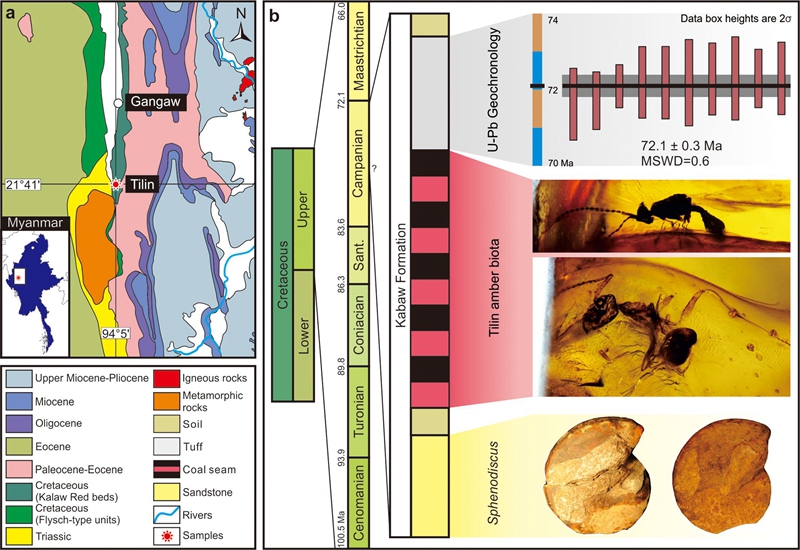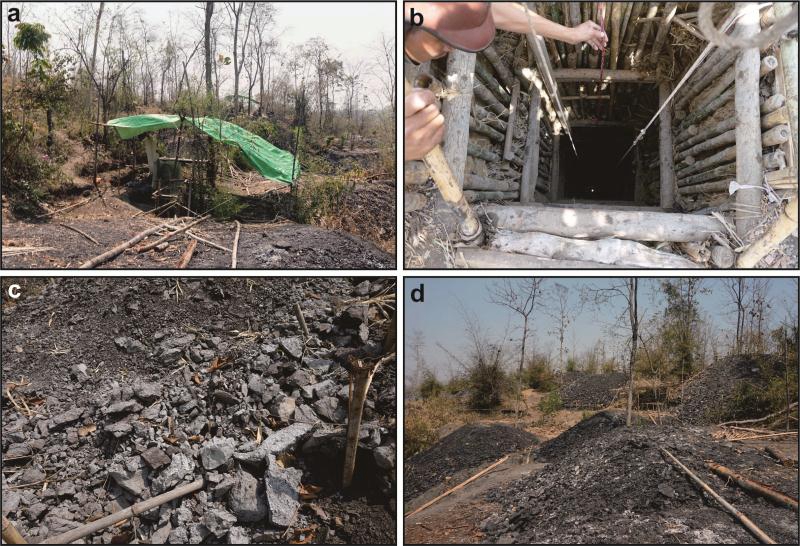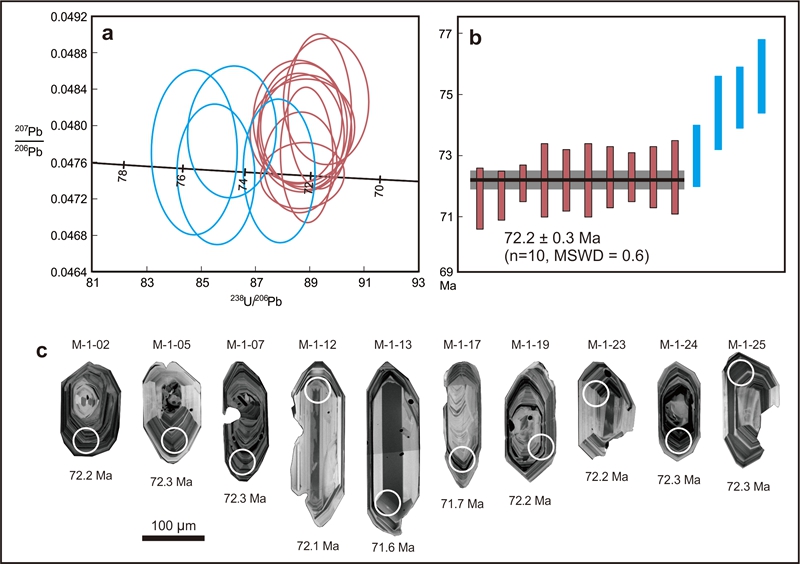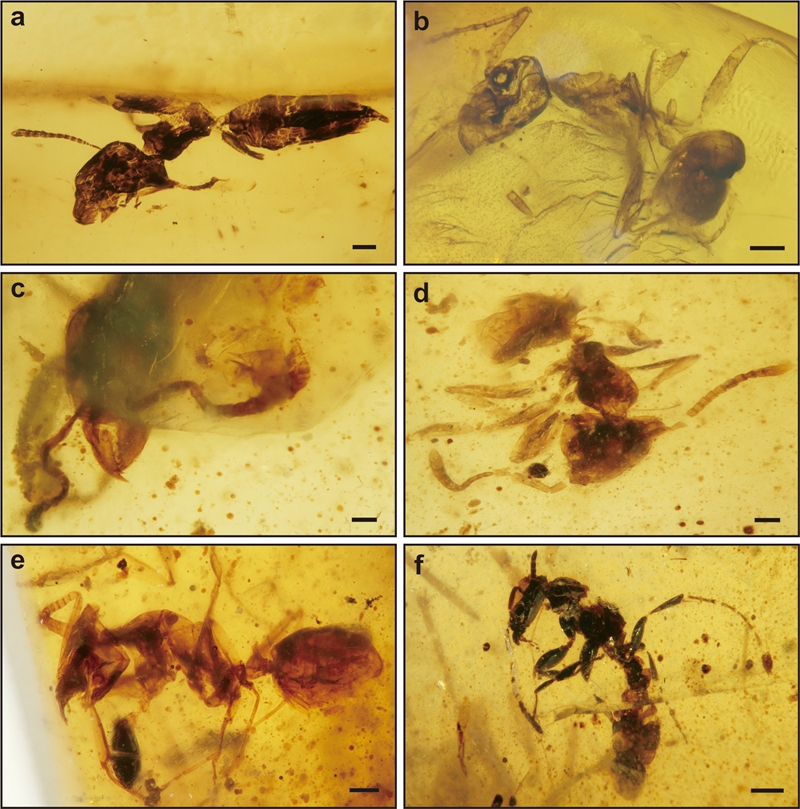In the past ten years, many important discoveries have been reported from Burmese amber. The well-known Burmese amber, also called Kachin amber, was from Kachin area of north Myanmar, with a geological age of ~98.8 Ma. However, very few geological investigations has been carried out for Kachin amber due to various reasons. In the past years, Dr. ZHWNG Daran and Prof. WANG Bo from the ‘Modern terrestrial ecosystem origin and early evolution’ group of Nanjing Institute of Geology and Palaeontology, Chinese Academy of Sciences have made detailed investigations for the amber sites in Myanmar. Recently, this group cooperated with researchers from Hong Kong, England, France and India found a new amber biota—Tilin amber biota (~72 .1Ma) from Tilin, Gangaw district, Magway region of central Myanmar. This research was published in Nature Communications on August 9, 2018.

Geology of Tilin amber
In Tilin, more than 30 pits distribute along the hill baron and a typical pit is generally 1 m wide and 10–20 m deep to reach amber-bearing layers. The amber samples are preserved in coal seams beneath a grey tuff and above a yellow sandstone intercalated by conglomerates near mine surface. One tuff sample was collected just above the amber-bearing layers for LA-MC-ICP-MS U-Pb dating. Most zircon grains separated from tuff exhibited euhedral morphologies and oscillatory zoning patterns, indicating an igneous origin and no obvious sedimentary transport. A total of 15 zircons (concordance > 98%) were analyzed. Ten analyses provide the youngest age at 72.1 ± 0.3 Ma (MSWD = 0.6), which is near the Campanian-Maastrichtian boundary, and indicates a latest Campanian age for the underlying amber-bearing layers.
Besides, some ammonites were found preserved in nodules of brown sandstone underlying the amber layer. They belong to the genus Sphenodiscus, which was considered to be originated from Campanian and restricted to the Maastrichtian, providing a late Campanian to Maastrichtian lower constraint for Tilin amber. Together with the radio-isotopic age for the upper constraint, Tilin amber should be within the latest Campanian age. As such, Tilin amber is at least 27 million years younger than Kachin amber.

Photograph of Tilin amber outcrop
The Tilin amber fragments were analyzed using Pyrolysis Gas Chromatography Mass Spectrometry (Py-GC-MS). Tilin amber is diagenetically altered, with diagnostic biomarkers degraded. The major pyrolysis products are aromatic compounds clearly indicating a gymnosperm origin. Although Tilin was close to Kachin in West Burma block during Cretaceous, Tilin amber is chemically clearly distinct from Kachin amber, which supposedly originated from araucarian or pinaceous trees.
Angiosperms explosively diversified in mid-Cretaceous time, and became dominant in forests worldwide by the Maastrichtian. However, the gymnosperm-derived Tilin amber suggests that gymnosperms were still abundant in the latest Campanian equatorial forests. Nowadays, the forests of Southeast Asia are dominated by dipterocarps (Dipterocarpaceae, a family of angiosperm), and dipterocarp fossils and resins are present in India and Southeast Asia by the Eocene. As such, the replacement of gymnosperms by dipterocarps in Southeast Asian forests most likely occurred from the Maastrichtian to Paleocene.

U-Pb geochronology for Tilin amber
Tilin amber is frequently translucent and reddish or yellowish in color. The amber pieces are usually small and seldom longer than 10 cm. A total of 52 arthropod and plant inclusions were found in 5 kg of amber. The insect fauna is composed of 12 families of eight orders, including Hymenoptera, Diptera, Hemiptera, Psocoptera, Coleoptera, Blattaria, Mantodea, and Neuroptera, and is dominated by Hymenoptera and Diptera (80% of all insects).
A notable discovery is six worker ants belonging to three unknown genera of the extant subfamily Dolichoderinae, as well as a dealate female likely of the Ponerinae. The ants from Tilin amber are one of the earliest records of crown group ants, as only two Cretaceous species have been definitively assigned to extant subfamilies until now. All other ants recorded earlier in the Cretaceous belong to extinct subfamilies. Our findings provide reliable evidence for the Late Cretaceous radiation of crown group ants, and the apparent absence of sphecomyrmines suggests that the turnover from stem-groups to crown groups had already begun by the latest Campanian.

Fig. 4 Photographs of ants in Tilin amber
Despite the large number of Cretaceous and Cenozoic insect faunas to date, there is a 24-million-year gap spanning from the early Campanian to the early Eocene, which dramatically hinders our understanding of the reorganization of terrestrial ecosystem and the impact of the K-Pg extinction event on the evolution of insects. Tilin amber biota yields the latest known diverse insect assemblage in the Mesozoic, and provides a unique window into a vanished tropical forest. The age, chemical components, and inclusions of Tilin amber are different from those of Kachin amber in northern Myanmar, showing a biotic change from mid-Cretaceous to Late Cretaceous.
This research was supported by the National Natural Science Foundation of China, the Strategic Priority Research Program (B) of the Chinese Academy of Sciences, and the HKU Seed Funding Program for Basic Research,
Download:
